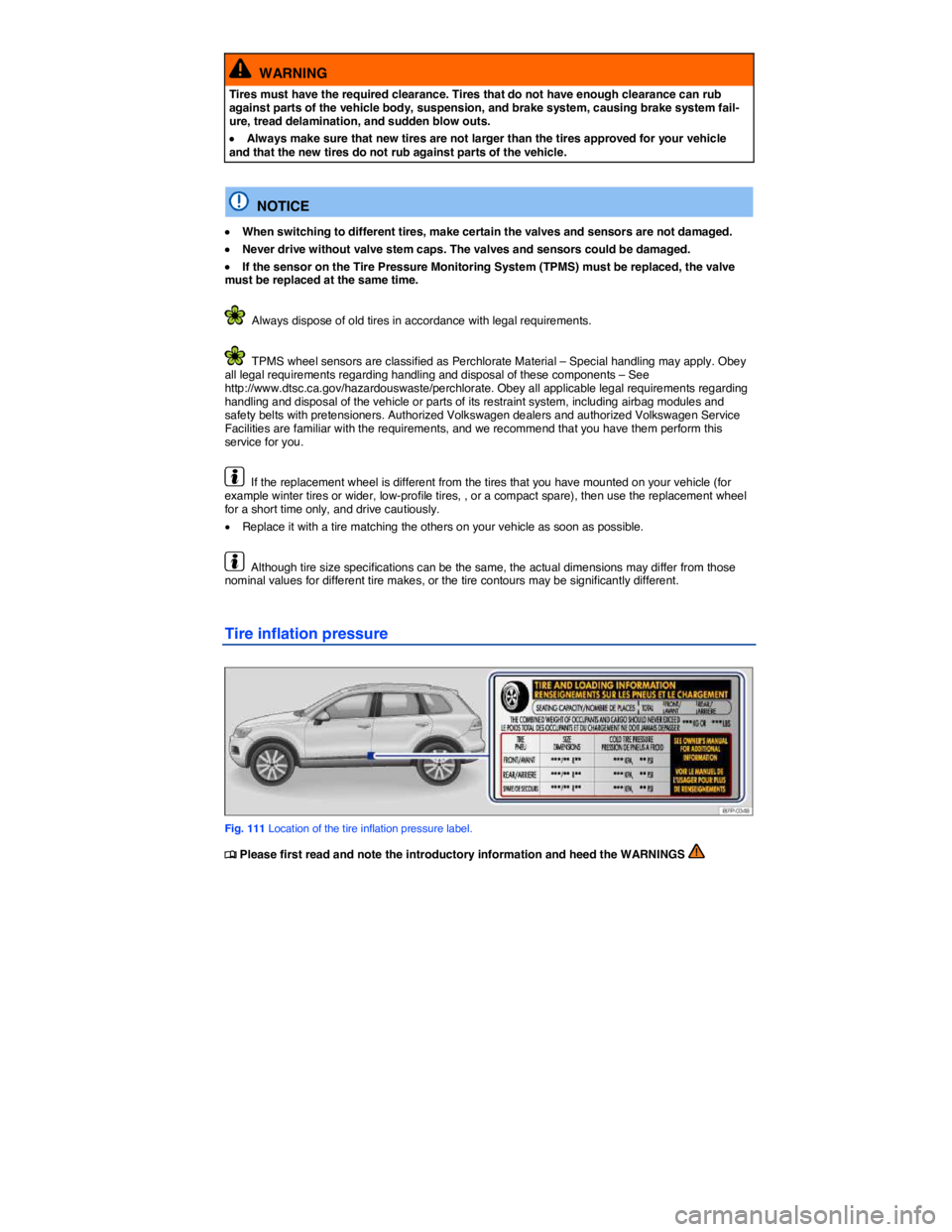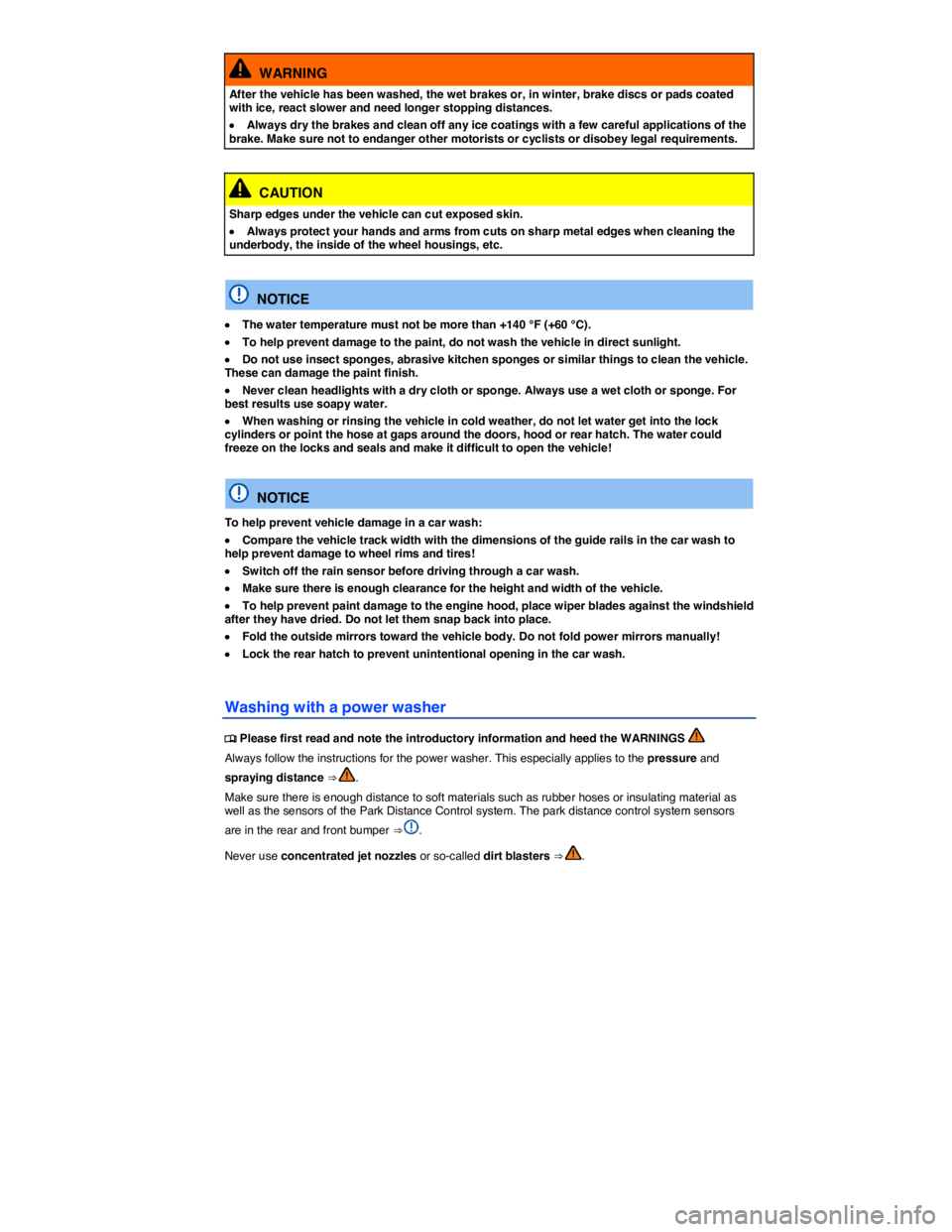winter tires VOLKSWAGEN TOUAREG 2012 Owners Manual
[x] Cancel search | Manufacturer: VOLKSWAGEN, Model Year: 2012, Model line: TOUAREG, Model: VOLKSWAGEN TOUAREG 2012Pages: 684, PDF Size: 6.36 MB
Page 15 of 684

Odometer displays
The odometer indicates the total distance driven by the vehicle.
The trip odometer (trip) shows the distance driven since the last time the trip odometer was reset. The last digit indicates 1/10 mile (100 meters).
Outside temperature display
At outside temperatures below about +39 °F (+4 °C), a “snowflake symbol” (icy road warning) appears in the display. The symbol flashes at first, then stays on until the outside temperature rises above
+43 °F (+6 °C) ⇒ .
When the vehicle is not moving or when you are driving at very low speeds, the temperature displayed may be slightly higher than the actual outside temperature.
The measurement range is from -40 °F (-40 °C) to +122 °F (+50 °C).
Compass display
When the ignition and navigation system are switched on, the current compass direction is indicated in
the instrument cluster display ⇒ Compass.
Selector lever positions
The selector lever position is shown both on the side of the selector lever and in the instrument cluster display. The respective gear may also be shown in the instrument cluster display in Drive (D) and Sport Drive (S), as well as in Tiptronic® mode.
Speed warning
If you exceed the top speed that has been set, this will be signaled in the instrument cluster display. This feature is useful in various situations, for instance when using winter tires that are not designed for the vehicle's top speed.
The speed warning can be set and switched on and off in the Infotainment System.
�x Switch on the ignition.
�x Press the CAR Infotainment button.
�x Tap the Settings function key on the screen.
�x Select Speed warning from the list.
�x Place your finger on the touchscreen slider �? and, keeping your finger on the screen, move your finger to slide it to the desired speed setting.
�x OR: Tap the - or + function key on the screen to move the slider in steps.
�x Tap the Active function key on the screen to switch on the speed warning.
If the check box in the Active function key is checked �=, the feature is switched on.
WARNING
Failure to heed warning lights and instrument cluster text messages can cause the vehicle to break down in traffic and result in a collision and serious personal injury.
�x Never ignore warning lights or text WARNINGS.
�x Always stop the vehicle as soon as it is safe to do so.
�x Park the vehicle at a safe distance from moving traffic and where no part of the hot cata-lytic converter and exhaust system can come into contact with flammable materials under the vehicle, such as dry grass, brush, spilled fuel, etc.
�x A broken down vehicle presents a high accident risk for itself and others. Switch on emergency flashers and set up a warning triangle to warn oncoming traffic.
Page 180 of 684

WARNING
Tires must have the required clearance. Tires that do not have enough clearance can rub against parts of the vehicle body, suspension, and brake system, causing brake system fail-ure, tread delamination, and sudden blow outs.
�x Always make sure that new tires are not larger than the tires approved for your vehicle and that the new tires do not rub against parts of the vehicle.
NOTICE
�x When switching to different tires, make certain the valves and sensors are not damaged.
�x Never drive without valve stem caps. The valves and sensors could be damaged.
�x If the sensor on the Tire Pressure Monitoring System (TPMS) must be replaced, the valve must be replaced at the same time.
Always dispose of old tires in accordance with legal requirements.
TPMS wheel sensors are classified as Perchlorate Material – Special handling may apply. Obey all legal requirements regarding handling and disposal of these components – See http://www.dtsc.ca.gov/hazardouswaste/perchlorate. Obey all applicable legal requirements regarding handling and disposal of the vehicle or parts of its restraint system, including airbag modules and safety belts with pretensioners. Authorized Volkswagen dealers and authorized Volkswagen Service Facilities are familiar with the requirements, and we recommend that you have them perform this service for you.
If the replacement wheel is different from the tires that you have mounted on your vehicle (for example winter tires or wider, low-profile tires, , or a compact spare), then use the replacement wheel for a short time only, and drive cautiously.
�x Replace it with a tire matching the others on your vehicle as soon as possible.
Although tire size specifications can be the same, the actual dimensions may differ from those nominal values for different tire makes, or the tire contours may be significantly different.
Tire inflation pressure
Fig. 111 Location of the tire inflation pressure label.
�
Page 181 of 684

The correct tire inflation pressure for factory-installed tires is listed on a label. The factory-installed
tires may be summer, winter, or all-season tires. The label ⇒ fig. 111 is on the driver door jamb.
Under- or over-inflation significantly shortens the service life of your tires and affects the handling of
the vehicle ⇒ . The correct tire pressure is very important, particularly when the vehicle is driven at higher speeds. Incorrect tire pressure causes increased wear and even sudden tire failure and blow-outs.
Therefore tire pressure should be checked at least once a month and always before long trips.
The specified tire inflation pressure applies to a cold tire. When tires are warm, the pressure will be higher than when the tires are cold.
Do not reduce the tire pressure on warm tires to match the required cold tire inflation pressure. The tire inflation pressure would then be too low and could cause sudden tire failure and blowout.
Checking tire inflation pressure
Always check the tire pressure on “cold” tires when the vehicle has not been driven more than a couple of miles (kilometers) at low speed within the last 3 hours.
�x Check tire inflation pressure regularly and on cold tires. Check all the tires, including the collapsible spare (if any). In colder climates tire pressure should be checked more often, but only when the tires are cold. Always use an accurate tire pressure gauge.
�x After adjusting the tire inflation pressures, make sure to screw the valve caps back on, replace missing valve caps immediately. Please read and heed the information on resetting the Tire Pressure
Monitoring System (TPMS) if necessary ⇒ Tire Pressure Monitoring System (TPMS).
�x Remember that the vehicle manufacturer, not the tire manufacturer, determines the correct tire pressure for the tires on your vehicle. Never exceed the maximum inflation pressure listed on the tire sidewall for any reason.
Inflate the spare wheel to the pressure specified for the vehicle's road wheels on the tire pressure label; inflate a compact spare wheel to the pressure specified for the compact spare on the tire pressure label or on a separate label for the compact spare, if there is one.
WARNING
Incorrect tire pressure can cause a sudden tire failure, or blowout, loss of control, collision, serious personal injury, and even death.
�x Always inflate tires to the recommended and correct cold tire pressure before driving off.
�x Low tire pressure can cause tires to get too hot, resulting in tread separation, sudden loss of pressure, and blowouts. Tires with excessively low pressure flex (bend) more, which can cause the tire to overheat and fail suddenly without warning.
�x Excessive speed and/or overloading can cause heat buildup, sudden tire failure including a blowout and sudden deflation and loss of control.
�x If the tire pressure is too low or too high, the tires will wear prematurely and the vehicle will not handle well.
�x Regularly check tire inflation pressure, at least once a month, and also especially before a long trip.
�x Check the pressure in all 4 tires when the tires are still cold. Never reduce air pressure in warm tires to match cold tire inflation pressure.
NOTICE
�x Make sure not to jam the tire pressure gauge into the valve stem. Otherwise you can dam-age the tire valves and the tire inflation pressure sensors.
Page 184 of 684

Tread depth
Most driving situations require as much tread depth as possible and similar tread depth for the tires on the front and rear wheels. This is especially true when driving in winter weather, at low temperatures
and under wet conditions ⇒ .
In most countries the legally permissible minimum tread depth is 06 in (1/16 in; 1.6 mm), as measured in tread grooves next to the wear indicators. Please be sure to obey country-specific legal require-ments.
Winter tires are no longer suitable for winter operation once the tread pattern is worn down to a depth of 3/16 in (4.8 mm).
The tread depth of new tires can differ between tire models and manufacturers because of the differ-ent design features and tread patterns.
Tread wear indicator (TWI) in the tire
The 1/16 in (1.6 mm) high wear indicators are molded into the bottom of the tread grooves of the
original tires running across the treads ⇒ fig. 112. Several wear indicators are evenly spaced around the tire. Markings on the sides of the tires (for example “TWI” or symbols) show the position of the wear indicators.
Wear indicators show when the tires are worn down. The tires must be replaced no later than when the tread pattern is worn down to the wear indicators.
WARNING
Worn tires are dangerous and can cause loss of vehicle control including serious personal injuries.
�x Never drive a vehicle when the tread on any tire is worn down to the wear indicators, re-place them sooner.
�x Worn tires do not grip the road properly, especially on wet roads, increasing your risk of “hydroplaning” and loss of control.
�x Worn tires reduce the ability of your vehicle to handle well in normal and difficult driving situations and increase braking distances and the risk of skidding.
Tire wear and damage
�
Page 193 of 684

WARNING
Using incorrect or unmatched tires and/or wheels or improper tire and wheel combinations can lead to loss of control, collision and serious personal injury.
�x Always use tires, wheels and wheel bolts that meet the specifications of the original facto-ry-installed tires or other combinations that have been specifically approved by the vehicle manufacturer.
�x All 4 wheels must be fitted with radial tires of the same type, the same size (tread circum-ference), and the same tread pattern. Driving with different tires reduces vehicle handling and can lead to a loss of control.
�x Never drive faster than the maximum speed for which the tires installed on your vehicle are rated because tires that are driven faster than their rated speed can fail suddenly.
�x Overloading tires can cause heat build-up, sudden tire failure, including a blowout and sudden deflation and loss of control.
�x Temperature grades apply to tires that are properly inflated and not over- or underinflated.
Winter tires
�
Page 194 of 684

All-wheel drive (4MOTION)
Vehicles with all-wheel drive and standard road wheels have good forward motion and traction even under wintery road conditions. However, Volkswagen recommends installing snow tires or all season tires on all 4 wheels to improve handling as well as braking performance.
If you use snow chains, please read and heed information and directions ⇒ Snow chains.
WARNING
Driving faster than the maximum speed for which the winter tires on your vehicle were de-signed can cause sudden tire failure including a blowout and sudden deflation, loss of con-trol, crashes and serious personal injuries.
�x Winter tires have a maximum speed rating that may be lower than your vehicle's maximum speed.
�x Never drive faster than the maximum speed for which the winter tires installed on your vehicle are rated because tires that are driven faster than their rated speed can fail suddenly.
�x Never exceed the maximum load rating for the winter tires installed on your vehicle.
Install summer tires promptly in the spring. Summer tires offer better handling characteristics for temperatures above +45 °F (+7 °C). They are quieter, do not wear as quickly, and reduce fuel con-sumption.
If factory-installed wheels and/or tires are replaced when installing winter tires, make sure that the wheels are equipped with sensors that are compatible with the factory-installed Tire Pressure
Monitoring System (TPMS) and that the tires are also compatible with the system ⇒ Tire Pressure Monitoring System (TPMS). If new tires are not identical to those that were removed and require different cold tire inflation pressure, the tire inflation pressure values must be reprogrammed for the
TPMS. Please see your authorized Volkswagen dealer or authorized Volkswagen Service Facility ⇒ Tire Pressure Monitoring System (TPMS).
If necessary, ask your authorized Volkswagen dealer or authorized Volkswagen Service Facility about permissible winter tire dimensions.
Snow chains
�
Page 594 of 684

WARNING
After the vehicle has been washed, the wet brakes or, in winter, brake discs or pads coated with ice, react slower and need longer stopping distances.
�x Always dry the brakes and clean off any ice coatings with a few careful applications of the brake. Make sure not to endanger other motorists or cyclists or disobey legal requirements.
CAUTION
Sharp edges under the vehicle can cut exposed skin.
�x Always protect your hands and arms from cuts on sharp metal edges when cleaning the underbody, the inside of the wheel housings, etc.
NOTICE
�x The water temperature must not be more than +140 °F (+60 °C).
�x To help prevent damage to the paint, do not wash the vehicle in direct sunlight.
�x Do not use insect sponges, abrasive kitchen sponges or similar things to clean the vehicle. These can damage the paint finish.
�x Never clean headlights with a dry cloth or sponge. Always use a wet cloth or sponge. For best results use soapy water.
�x When washing or rinsing the vehicle in cold weather, do not let water get into the lock cylinders or point the hose at gaps around the doors, hood or rear hatch. The water could freeze on the locks and seals and make it difficult to open the vehicle!
NOTICE
To help prevent vehicle damage in a car wash:
�x Compare the vehicle track width with the dimensions of the guide rails in the car wash to help prevent damage to wheel rims and tires!
�x Switch off the rain sensor before driving through a car wash.
�x Make sure there is enough clearance for the height and width of the vehicle.
�x To help prevent paint damage to the engine hood, place wiper blades against the windshield after they have dried. Do not let them snap back into place.
�x Fold the outside mirrors toward the vehicle body. Do not fold power mirrors manually!
�x Lock the rear hatch to prevent unintentional opening in the car wash.
Washing with a power washer
�
Page 595 of 684

Never use a power washer to clean the engine compartment ⇒ Cleaning the engine compartment.
WARNING
Improper use of power washers can cause serious invisible permanent damage leading to tire failure and loss of vehicle control. This can cause accidents and severe personal injury.
�x Keep sufficient distance between water jet and tires. Never wash tires with a nozzle that sprays the water out in a direct stream regardless of the distance to the tire and even for a very short time.
�x Never use “dirt blasters.” to clean tires. Even spraying from a relatively long distance for a very short time can do visible or invisible damage to tires.
WARNING
After the vehicle has been washed, the wet brakes or, in winter, brake discs or pads coated with ice, react slower and need longer stopping distances.
�x Always dry the brakes and clean off any ice coatings with a few careful applications of the brake. Make sure not to endanger other motorists or cyclists or disobey legal requirements.
NOTICE
�x Water temperature should not be more than 140° F (60° C).
�x To help prevent damage to the paint, do not wash the vehicle in direct sunlight.
�x In order for Park Distance Control to work correctly, the sensors in the bumpers must be kept clean and clear of snow and ice.
�x When using a power washer or steam cleaner, only spray the rear assist sensors directly for a short period of time and always keep the nozzle at least 4 inches (10 cm) from the sensor.
�x Do not clean icy or snow-covered windows with a power washer.
�x When washing or rinsing the vehicle in cold weather, do not let water get into the lock cylinders or point the hose at gaps around the doors, hood or rear hatch. The water could freeze on the locks and seals and make it difficult to open the vehicle!
Cleaning windows and outside mirrors
�